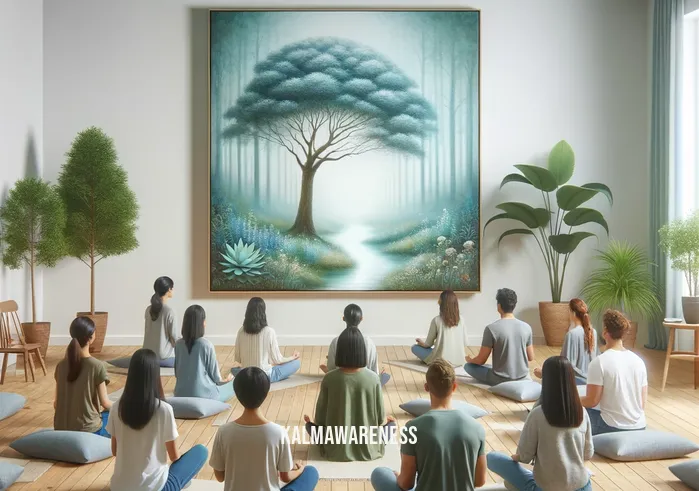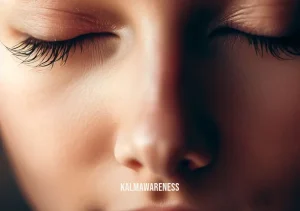Which of the Following Statements About Mindfulness is True?
In our pursuit of well-being and inner peace, the concept of mindfulness has become a central focus for many. As we embark on this explorative journey into the realm of mindfulness, we’ll unravel the truths and misconceptions surrounding this ancient practice. Our voyage begins with the fundamental understanding of mindfulness, its significance in the mind-body connection, and its role in fostering a state of heightened awareness. By the culmination of this discussion, we aim to provide clarity on the pressing question: which of the following statements about mindfulness is true?
Understanding Mindfulness and Its Roots
Mindfulness, at its core, involves immersing oneself completely in the present moment. It’s the art of being deeply engaged with the ongoing experiences, without being overwhelmed or overly reactive. Mindfulness asks us to touch that body part of our consciousness that observes without judgment, facilitating a connection between our inner and outer worlds. Interestingly, this practice finds its roots in ancient meditative traditions, and has been particularly influential among teenagers walking the path of spiritual discovery.
The Importance of Mindful Awareness
A critical aspect to keep in mind while diving into mindfulness is the principle of awareness. The act of being aware, not just of your external surroundings but also of your internal states, emotions, and thoughts, is a cornerstone of mindfulness. Studies have shown that regular practice can enhance this sense of awareness, which in turn stabilizes our emotional well-being and cognitive functions. This stability often manifests as a peaceful state of mind, devoid of unnecessary worries and overthinking.
Mindfulness in Everyday Life
Many mistakenly believe that to practice mindfulness, one needs to be seated in a quiet corner, possibly in a lotus position. However, mindfulness can be incorporated into everyday activities. Whether it’s through mindful hypnobirthing, performing rouse yoga, or even during seemingly mundane tasks, the opportunity to be present is always available. For those wondering, it’s entirely possible to meditate lying down. The key lies in the intention and the dedication to cultivate an ongoing relationship with the present moment.
Dispelling Common Myths
As with any popular concept, misconceptions about mindfulness abound. Some believe it’s purely a form of meditation. Others see it as a retreat from reality. In truth, mindfulness is neither an escape nor limited to a single practice. It’s about cultivating a judgment of the wise—observing without immediately reacting. Practices like mirror gazing can offer spiritual benefits, while techniques like gratitude meditation enhance appreciation for the present. As we’ll see in upcoming segments, understanding mindfulness requires delving deeper than common perceptions.
The Road Ahead
Our introductory foray into the world of mindfulness offers a glimpse into its rich tapestry. We’ve scratched the surface of this intricate topic, touching upon its origins, principles, and widespread misconceptions. But as we’ll explore in subsequent segments, there’s so much more to learn. From its role in sustainable self-care to understanding how meditation made simple can be a game-changer, our journey has only just begun. Armed with expert insights from sources like Jack Kornfield’s meditation for beginners, we’ll dissect the multi-faceted elements of mindfulness, ultimately leading us to an informed answer to our central question.
Eager to delve deeper? I invite you to continue reading in the next segment, where we’ll explore the tangible benefits of mindfulness in daily life, backed by science and centuries of human experience.

Unraveling Truths: Mindfulness Explored
In our exploration of the pivotal question—which of the following statements about mindfulness is true?—it’s essential to venture beyond the surface. Mindfulness is not just a buzzword; it’s an intricate tapestry woven from threads of ancient wisdom, scientific inquiry, and modern application. As we delve deeper, let’s demystify some commonly held beliefs, offering a clearer, more nuanced perspective.
The Many Faces of Mindfulness: An Overview
Mindfulness is often oversimplified, but it encompasses a plethora of practices and principles. Let’s consider some key elements:
- Mindful Movements: While meditation is a cornerstone, there’s a universe of mindful exercises that help synchronize the body and mind.
- Daily Rituals: Every action, from how we get deep so fast into our morning routines to our nightly gratitude practices, can be infused with mindfulness.
- Mind Training: Techniques to train your mind to be stronger than your feelings emphasize resilience and emotional regulation.
- Consistent Practice: Like any skill, mindfulness flourishes with regularity. Whether it’s a meditation made simple approach or more advanced techniques, consistency is key.
Mindfulness Statements: True or False?
To gain clarity on which of the following statements about mindfulness is true?, let’s layout some statements and evaluate their accuracy.
| Statement | True/False | Brief Explanation |
|---|---|---|
| Mindfulness is exclusively about meditation. | False | While meditation is integral, mindfulness spans beyond to include daily activities, thoughts, and emotions. |
| One can practice mindfulness only in solitude. | False | Whether in a bustling city or during one for each blessed day, mindfulness can be practiced anywhere. |
| Mindfulness demands perfection and complete control over thoughts. | False | It’s about awareness and non-judgment, not control. |
| Mindfulness can lead to improved mental well-being. | True | Numerous studies highlight benefits like reduced anxiety and enhanced clarity. |
| Only certain people can achieve true mindfulness. | False | With practice, anyone can harness the power of mindfulness, regardless of age or background. |
The Lasting Impacts of Mindful Living
The implications of a mindful lifestyle ripple across our lives. Some noteworthy impacts include:
- Enhanced Self-awareness: By observing our thoughts without judgment, we cultivate a deeper understanding of ourselves.
- Reduced Stress: Embracing practices like sustainable self-care can alleviate the pressures of modern life.
- Emotional Regulation: Mindfulness provides tools to navigate emotional turbulence, fostering equilibrium.
- Improved Relationships: By being present, we foster deeper connections with loved ones and peers.
- Augmented Creativity: A clear mind often becomes a fountainhead of innovative ideas and solutions.
The Road to Mindful Mastery
As we’ve seen, mindfulness isn’t a monolithic concept but a multifaceted journey. Whether you’re seeking the serene depths of Jack Kornfield’s meditation for beginners or wish to adopt a daily ritual, the landscape is vast and welcoming.
Intrigued by the revelations so far? The journey has only just begun. Continue reading in the next segment as we delve into the science behind mindfulness, exploring empirical evidence, and decoding how this ancient practice harmonizes with contemporary neuroscience.

Seeds of Hope: Mindfulness as a Beacon in Turbulent Times
Mindfulness, as we’ve discerned, is multifaceted and profound. Yet, its most remarkable aspect might be its capacity to inspire hope, especially when shadows loom large. In the quest to discern which of the following statements about mindfulness is true?, we uncover stories brimming with resilience, transformation, and optimism.
Echoes of Wisdom: Mindfulness Quotes
Throughout history, luminaries have distilled their experiences with mindfulness into words, offering solace and enlightenment. Here are a few handpicked quotes that beautifully encapsulate its essence:
- Thich Nhat Hanh: “The present moment is the only moment available to us, and it is the door to all moments.”
- Jon Kabat-Zinn: “Mindfulness is the aware, balanced acceptance of the present experience. It isn’t more complicated than that. It is opening to or receiving the present moment, pleasant or unpleasant, just as it is, without either clinging to it or rejecting it.”
- Rumi: “Do not be satisfied with the stories that come before you. Unfold your own myth.”
- Eckhart Tolle: “Realize deeply that the present moment is all you have. Make the NOW the primary focus of your life.”
- Sharon Salzberg: “Mindfulness isn’t difficult. We just need to remember to do it.”
Each of these quotes underscores the transformative potential of living in the present, of tethering oneself to the ‘now.’ They serve as a testament to the power of awareness in shaping our narratives, both internal and external.
Lighting the Path: Real-life Tales of Transformation
Let’s immerse ourselves in some heartening tales that reaffirm the potency of mindfulness:
Sarah’s Journey to Self-compassion: Plagued by low self-esteem and relentless self-criticism, Sarah stumbled upon a mindful hypnobirthing workshop during her pregnancy. Not only did it ease her birthing experience, but it also illuminated a path to self-love. Today, she champions mindfulness, crediting it for her metamorphosis from self-doubt to self-assuredness.
David’s Escape from the Corporate Quagmire: Feeling entrapped in the corporate rat race, David felt a void, a sense of purposelessness. His breakthrough came when he attended a retreat focusing on the judgement of the wise. Learning to release his judgment, he forged a new career path that married his skills with his passion for social impact.
Anita’s Dance with Serenity: Facing the trials of a tumultuous personal life, Anita found solace in mirror gazing spiritual benefits, an ancient mindful practice. By confronting and embracing her reflections, both literal and metaphorical, she learned the art of inner tranquility.
Embracing the Journey
While mindfulness promises serenity and insight, it’s essential to keep in mind that it’s more about the journey than the destination. It’s not a panacea but a compass—a tool to navigate life’s maze with heightened awareness and grace.
Mindfulness invites us to unearth our innate resilience, guiding us towards a life of richness, replete with deep connections, gratitude, and joy. As we’ve gleaned from the real-life tales, it offers a sanctuary, a space to recalibrate and rejuvenate.
As we journey forth, our exploration continues, shedding light on the myriad dimensions of mindfulness. In the next chapter, we will delve into the profound interplay between mindfulness and physiology, unearthing the symbiotic relationship between the mind and body. Stay with us as we bridge ancient wisdom with modern science, offering a holistic perspective.
@
Demystifying Mindfulness: Unraveling the Truths
In our exploration to determine which of the following statements about mindfulness is true?, we’ve journeyed through its origins, its inspirations, and its transformative power. Now, let’s delve deeper, breaking down some common beliefs and misconceptions about mindfulness. By understanding its intricate layers, we can more fully embrace its potential.
Common Beliefs about Mindfulness
A State of Inactivity: Many assume that mindfulness involves complete stillness, especially in practices like meditation. However, mindful movement sleep teaches us that mindfulness can be incorporated into physical activities, blending awareness with motion.
Only for Adults: A prevalent notion is that mindfulness is an adult-only domain. But methods like teenagers walking reveal that younger generations can also benefit from these practices.
Requires Expertise: Some believe that true mindfulness can only be achieved under the guidance of an expert. While teachers can be invaluable, resources such as Jack Kornfield meditation for beginners show that one can embark on this journey independently.
Misconceptions and Their Clarifications
Mindfulness Equals Meditation: While meditation is a powerful tool within the mindfulness spectrum, they aren’t synonymous. As practices like rouse yoga demonstrate, mindfulness spans a broad range of activities.
- Truth: Meditation is an element of mindfulness, but not its entirety.
It’s a Quick Fix: Some perceive mindfulness as a swift solution to life’s problems. Yet, as the process of how we get deep so fast illustrates, it’s a continual journey rather than an instant remedy.
- Truth: Mindfulness is a life-long practice that requires dedication and patience.
Mindfulness is a Religion: Associating mindfulness solely with Buddhism or any other religion limits its universal appeal. While it has spiritual roots, practices like meditation made simple are secular and accessible to all.
- Truth: Mindfulness transcends religious boundaries and is a practice of human experience.
Benefits of Mindfulness: A Recap
- Physical Well-being: Enhances sleep quality, reduces stress hormones, and boosts the immune system.
- Emotional Balance: Equips individuals with tools to cope with negative emotions, fostering resilience.
- Cognitive Enhancement: Sharpens attention, promotes clarity, and aids in decision-making.
- Relationships: Encourages empathy and active listening, strengthening interpersonal bonds.
The Role of Daily Practices
Integrating mindfulness into daily life doesn’t require drastic changes. Simple acts, such as gratitude meditation before sleep, can set the tone for a fulfilling, mindful existence.
With this clarified understanding, we’re better equipped to discern the essence of mindfulness, separating facts from fiction. As we move into our concluding chapter, we will synthesize our findings, providing a comprehensive answer to which of the following statements about mindfulness is true?. Join us in this final leg of our exploration, as we distill the essence of mindfulness and present its profound truths.
@
Mindfulness Uncovered: Reflecting on Our Exploration
Our journey to discern which of the following statements about mindfulness is true? has been enlightening. From its foundational concepts to its multifaceted applications, we’ve traversed the vast landscape of mindfulness, gleaning insights that can enrich our daily lives.
The Tapestry of Truths
Mindfulness is not just a fleeting trend or a buzzword. It’s a profound practice that has been cultivated over millennia, grounded in sustainable self-care and deep introspection. Far from being a passive state, mindfulness is an active engagement with the present, an invitation to touch that body part of our experience that often goes unnoticed.
Moreover, as we’ve delved into practices like mindful hypnobirthing, we’ve seen how mindfulness isn’t just about individual well-being. It’s a communal practice that can enrich relationships, foster compassion, and bridge divides.
Reflections and Takeaways
Mindfulness is Universal: It transcends religious, cultural, and age boundaries, offering tools to anyone willing to explore.
It’s a Journey, not a Destination: As elucidated by how to spell stabilize, achieving mindfulness is a continuous process, not a fixed state.
Transformative Potential: Embracing mindfulness can reshape our perspectives, enhancing not just individual lives but also impacting communities and societies.
A Call to Dive Deeper
Our exploration has merely scratched the surface. The vast realm of mindfulness offers myriad practices, philosophies, and perspectives. To those curious souls yearning to delve deeper, we recommend exploring practices like mirror gazing for spiritual benefits or embracing the judgement of the wise.
Additionally, we urge readers to revisit our chapters, assimilate the insights, and experiment with the practices shared. Every reread might offer a fresh revelation!
Gratitude and a Glimpse Forward
We’re incredibly grateful for the time you’ve invested in this exploration with us. It’s our hope that these insights not only illuminate your understanding but also inspire action. Remember, the true magic of mindfulness unfolds when knowledge transforms into lived experience.
Stay tuned for more in-depth explorations and enlightening journeys in our upcoming editions. The world of mindfulness is vast and ever-evolving, and we’re excited to continue this exploration together.
Thank you for joining us on this journey, and until next time, may you find peace, clarity, and joy in the present moment.




